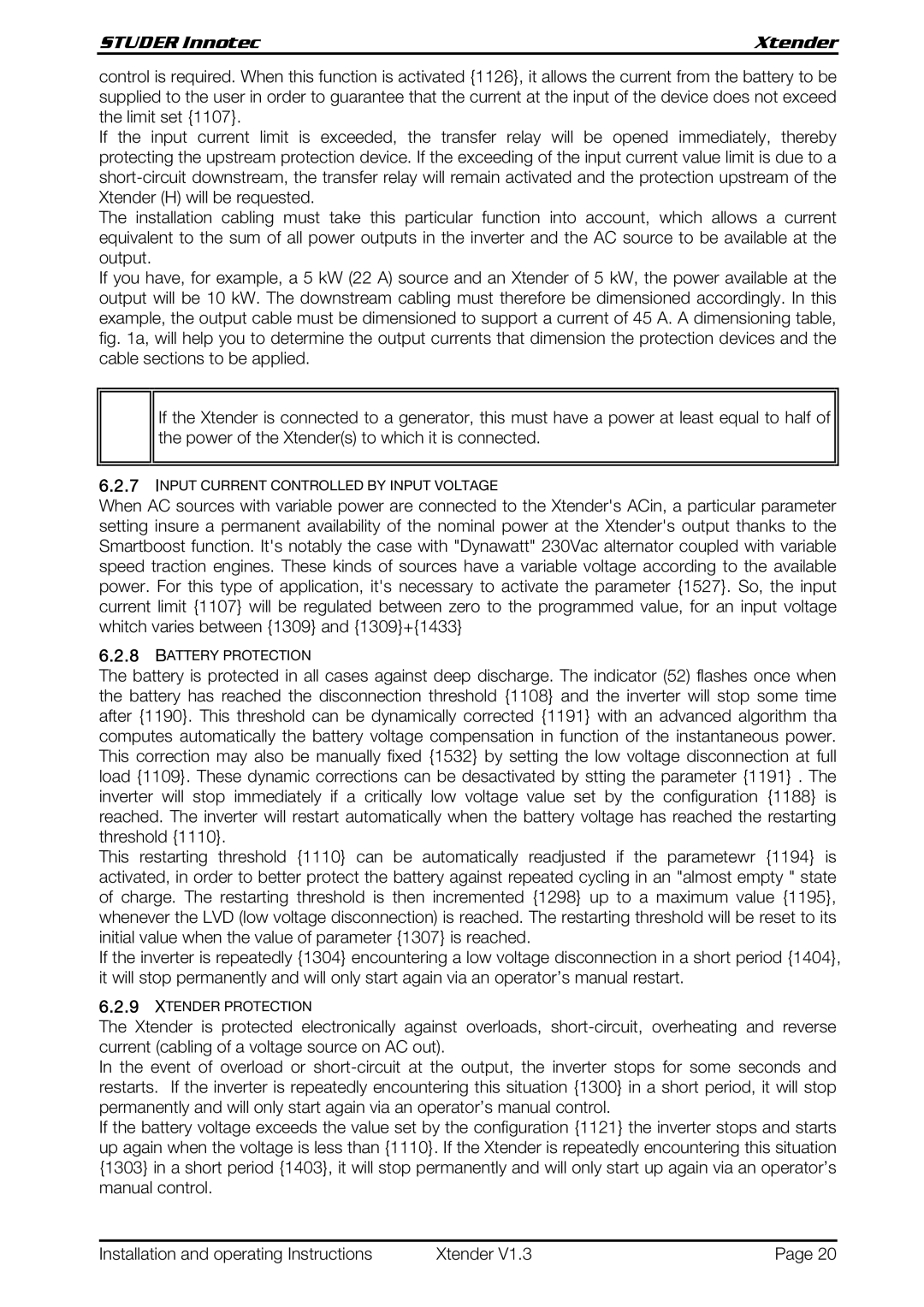
STUDER Innotec | Xtender |
control is required. When this function is activated {1126}, it allows the current from the battery to be supplied to the user in order to guarantee that the current at the input of the device does not exceed the limit set {1107}.
If the input current limit is exceeded, the transfer relay will be opened immediately, thereby protecting the upstream protection device. If the exceeding of the input current value limit is due to a
The installation cabling must take this particular function into account, which allows a current equivalent to the sum of all power outputs in the inverter and the AC source to be available at the output.
If you have, for example, a 5 kW (22 A) source and an Xtender of 5 kW, the power available at the output will be 10 kW. The downstream cabling must therefore be dimensioned accordingly. In this example, the output cable must be dimensioned to support a current of 45 A. A dimensioning table, fig. 1a, will help you to determine the output currents that dimension the protection devices and the cable sections to be applied.
If the Xtender is connected to a generator, this must have a power at least equal to half of the power of the Xtender(s) to which it is connected.
6.2.7INPUT CURRENT CONTROLLED BY INPUT VOLTAGE
When AC sources with variable power are connected to the Xtender's ACin, a particular parameter setting insure a permanent availability of the nominal power at the Xtender's output thanks to the Smartboost function. It's notably the case with "Dynawatt" 230Vac alternator coupled with variable speed traction engines. These kinds of sources have a variable voltage according to the available power. For this type of application, it's necessary to activate the parameter {1527}. So, the input current limit {1107} will be regulated between zero to the programmed value, for an input voltage whitch varies between {1309} and {1309}+{1433}
6.2.8BATTERY PROTECTION
The battery is protected in all cases against deep discharge. The indicator (52) flashes once when the battery has reached the disconnection threshold {1108} and the inverter will stop some time after {1190}. This threshold can be dynamically corrected {1191} with an advanced algorithm tha computes automatically the battery voltage compensation in function of the instantaneous power. This correction may also be manually fixed {1532} by setting the low voltage disconnection at full load {1109}. These dynamic corrections can be desactivated by stting the parameter {1191} . The inverter will stop immediately if a critically low voltage value set by the configuration {1188} is reached. The inverter will restart automatically when the battery voltage has reached the restarting threshold {1110}.
This restarting threshold {1110} can be automatically readjusted if the parametewr {1194} is activated, in order to better protect the battery against repeated cycling in an "almost empty " state of charge. The restarting threshold is then incremented {1298} up to a maximum value {1195}, whenever the LVD (low voltage disconnection) is reached. The restarting threshold will be reset to its initial value when the value of parameter {1307} is reached.
If the inverter is repeatedly {1304} encountering a low voltage disconnection in a short period {1404}, it will stop permanently and will only start again via an operator’s manual restart.
6.2.9XTENDER PROTECTION
The Xtender is protected electronically against overloads,
In the event of overload or
If the battery voltage exceeds the value set by the configuration {1121} the inverter stops and starts up again when the voltage is less than {1110}. If the Xtender is repeatedly encountering this situation {1303} in a short period {1403}, it will stop permanently and will only start up again via an operator’s manual control.
Installation and operating Instructions | Xtender V1.3 | Page 20 |
